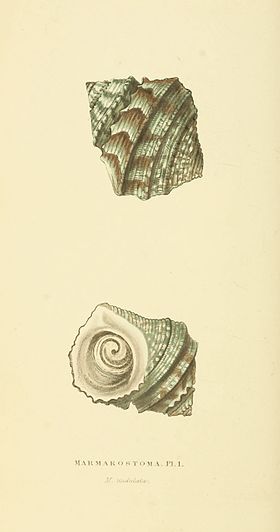Zoological Illustrations Series II/Plate 14
MARMAROSTOMA. Pl. 1.
M. undulata.
MARMAROSTOMA undulata.
Waved Pearl Snail.
Generic Character.
Shell turbinated, ponderous, the whorls generally angulated, the substance pearly: aperture circular, closed by a testaceous operculum: umbilicus none.
Type, Turbo chrysostomus. L.
Specific Character.
Shell angulated, variegated with green and brown undulated stripes, summit of each whorl coronated.
From the genera Turbo and Trochus of modern Conchologists, we have detached all those species whose shells are closed by a calcarious operculum; and this group we propose to distinguish by the name of Marmarostoma. The species, like the Trochi, properly so called, are all of a pearly structure; but their substance is much thicker; the base of the shell is slightly produced; the exterior surface is marked either with tubercles, grooves, or elevated ridges; and the aperture (from the convexity of the last whorl) forms a circle. If the student compares these characters with Trochus Zizyphinus, a common British shell, he will immediately perceive the leading differences between the two groups.
But it is the calcarious nature of the operculum (as indicating an important difference in the organization of the animal) which constitutes the primary character of Marmarostoma: the particular structure of this appendage varies considerably in the different species: in some its outer surface is smooth and convex; and in others variously granulated. In the present shell it is marked by three or four deep semicircular grooves; that nearest the middle is the deepest, and terminates in an umbilicus. In some specimens, the spines on the principal ridge of the body whorl are nearly obsolete; but those which crown the summit appear constant.
We are indebted to the Rev. Mr. Bulwer, a scientific and arduous Conchologist, for our specimens of this new species, purchased by him in a collection sent from Panama.

